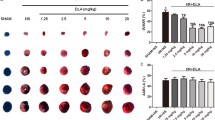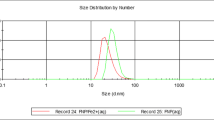Abstract
Lactate dehydrogenase (LDH, EC1.1.1.27), widely expressed in the heart, liver, and other tissues, plays an important role in glycolysis and glyconeogenesis. The activity of LDH is often altered upon inflammatory responses in animals. Nano-TiO2 was shown to provoke various inflammatory responses both in rats and mice; however, the molecular mechanism by which TiO2 exerts its toxicity has not been completely understood. In this report, we investigated the mechanisms of nano-anatase TiO2 (5 nm) on LDH activity in vitro. Our results showed that LDH activity was greatly increased by low concentration of nano-anatase TiO2, while it was decreased by high concentration of nano-anatase TiO2. The spectroscopic assays revealed that the nano-anatase TiO2 particles were directly bound to LDH with mole ratio of [nano-anatase TiO2] to [LDH] was 0.12, indicating that each Ti atom was coordinated with five oxygen/nitrogen atoms and a sulfur atoms of amino acid residues with the Ti–O(N) and Ti–S bond lengths of 1.79 and 2.41 Å. We postulated that the bound nano-anatase TiO2 altered the secondary structure of LDH, created a new metal ion-active site for LDH, and thereby enhanced LDH activity.





Similar content being viewed by others
References
Service R F (2003) American Chemical Society meeting: nanomaterials show signs of toxicity. Sci 300: 243.
Brumfiel G A (2003) Little knowledge. Nature 424(17): 246.
Zhang W X (2003) Environmental technologies at the nanoscale. Environ Sci Technol 37(5): 103–108.
Kelly K L (2004) Nanotechnology grows up. Sci 304: 1732–1734.
Sayes, C.M., Wahi, R., Kurian, P.A., Liu, Y.P., West, J.L., Ausman, K.D., Warheit, D.B., Colvin V.L., 2006 Correlating nanoscale titania structure with toxicity: a cytotoxicity and inflammatory response study with human dermal fibroblasts and human lung epithelial cells. Toxicol Sci 92, 174–185.
Wang B, Feng WY, Zhao Y L, Xing G M, Chai ZF, Wang HF, Jia G (2005) Status of study on biological and toxicological effects of nanoscale materials. Sci China, Ser B 48(5): 385–394.
Crabtree R H (1998) A new type of hydrogen bond. Sci 282: 2000–2001.
Wang J Y, Zhu S G, Xu C F ed. (2002) Biochemistry. Higher Education Press, Beijing, pp. 356,362, 428 (in Chin).
Bermudez E, Mangum JB,Wong BA, Asgharian B, Hext PM, Warheit DB, Everitt JI (2004) Pulmonary responses of mice, rats, and hamsters to subchronic inhalation of ultrafine titanium dioxide particles. Toxicol Sci 77: 347–357.
Bermudez E, Mangum JB, Asgharian B, Wong BA, Reverdy E, Janszen DB, Hext PM, Warheit DB, Everitt JI (2002) Long-term pulmonary responses of three laboratory rodent species to subchronic inhalation of pigmentary titanium dioxide particles. Toxicol Sci 70: 86–97.
Driscoll KE, Lindenschmidt RC, Maure JK, Higgins JM, Ridder G (1990) Pulmonary response to silica or titanium dioxide: inflammatory cells, alveolar macrophage-derived cytokines, and histopathology. Am J Respir Cell Mol Biol 2: 381–390.
Driscoll KE, Maurer JK, Lindenschmidt RC, Romberger D, Rennard SI, Crosby L (1990) Respiratory tract responses to dust: relationships between dust burden, lung injury, alveolar macrophage fibronectin release, and the development of pulmonary fibrosis. Toxicol Appl Pharmacol 106: 88–101.
Henderson RF, Driscoll KE, Harkema JR, Lindenschmidt RC, Chang IY, Maples KR, Barr EB (1995) A comparison of the inflammatory response of the lung to inhaled versus instilled particles in F344 rats. Fundam Appl Toxicol 24: 183–197.
Warheit DB, Brock WJ, Lee KP, Webb TR, Reed KL (2005) Comparative pulmonary toxicity inhalation and instillation studies with different TiO2 particle formulations: impact of surface treatments on particle toxicity. Toxicol Sci 88 (2):514–524.
Afaq F, Abidi P, Matin R, Rahman Q (1998) Cytotoxicity, pro-oxidant effects and antioxidant depletion in rat lung alveolar macrophages exposed to ultrafine titanium dioxide. J Appl Toxicol 18: 307–312.
Oberdörster G, Finkelstein J N, Johnston C (2000) Acute pulmonary effects of ultrafine particles in rats and mice. Res Rep Health Eff Inst 96: 5–74.
Wang J X, Zhou G Q, Chen C Y, Yu H W, Wang T C, Ma Y M, Jia G, Gao Y X, Li B, Sun J, Li Y F, Jia F, Zhao Y L, Chai Z F (2007) Acute toxicity and biodistribution of different sized titanium dioxide particles in mice after oral administration. Toxicol Lett 168: 176–185.
Liu HT, Ma L L, Zhao J F, Liu J, Yan JY, Ruan J, Hong FS (2009) Biochemical toxicity of nano-anatase TiO2 particles in mice. Biol Trace Element Res, doi:10.1007/s12011-008-8285-6 (in press)
Yang P, Lu C, Hua N, Du Y (2002) Titanim dioxide nanoparticles co-doped with Fe3+ and Eu3+ ions for photocatalysis. Mater Lett 57: 794–801.
Wotton I D P (1964) Enzymes in blood. In Microanalysis in Medical Biochemistry, pp. 101–118, Churchill, London.
Ankudinov A, Ravel B, Rehr J J, Conradson S D (1998) Real-space multiple-scattering calculation and interpretation of x-ray-absorption near-edge structure. Phys Rev B 58: 7565–7576.
Perczel A, Park K, Fasman G D (1992) Analysis of the circular dichroism spectrum of proteins using the convex constraint algorithm: a practical guide. Anal Biochem 203: 83–89.
Chen Z, Meng H, Xing G M, Chen C Y, Zhao Y L, Jia G, Wang T C, Yuan H, Ye C, Zhao F, Chai Z F, Zhu C F, Fang X H, Ma B C, Wan L J (2006) Acute toxicological effects of copper nanoparticles in vivo. Toxicol Lett 163: 109–120.
Hong F S, Wu C, Liu C, Wang L, Gao F Q, Yang F, Xu J H, Liu T, Xie Y N, Li Z R (2007) Direct interaction between lead ions and DNA from kidney of silver crucian carp. Chemosphere 69: 1442–1446.
Nagami H, Yoshimoto N, Umakoshi H (2005) Liposome-assisted activity of superoxida dismutase under oxidative stress. J. Biosci Bioeng 99(4): 423–428.
Acknowledgments
This work was supported by the National Natural Science Foundation of China (grant no. 20671067) and by the Medical Development Foundation of Suzhou University (grant no. EE120701) and by the National New Ideas Foundation of Student (grant no. 57315427).
Author information
Authors and Affiliations
Corresponding author
Additional information
Y. Duan, H. Liu, and J. Zhao contributed equally to this work.
Rights and permissions
About this article
Cite this article
Duan, Y., Liu, H., Zhao, J. et al. The Effects of Nano-anatase TiO2 on the Activation of Lactate Dehydrogenase from Rat Heart. Biol Trace Elem Res 130, 162–171 (2009). https://doi.org/10.1007/s12011-009-8326-9
Received:
Accepted:
Published:
Issue Date:
DOI: https://doi.org/10.1007/s12011-009-8326-9




